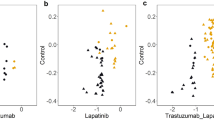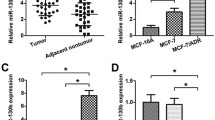Abstract
This study was designed to compare usnic acid with anti-breast cancer drug molecules (A-BCDM) routinely used in the treatment of breast cancer. The miRNA information of 17 anti-breast cancer drug used in breast cancer treatment was obtained from the Small Molecule-miRNA Network-Based Inferance (SMIR-NBI) tool. We had been determined common and different expressed miRNAs between 17 A-BCDM & usnic acid and were classified according to the common miRNAs to reveal molecular similarity. As a result of the bioinformatic analyzes, 20 common miRNAs were determined between 17 A-BCDM and usnic acid. The common miRNAs were analyzed with bioinformatic tolls for determining pathways and targets. The most common miRNAs for 6 of 17 A-BCDM and usnic acid were determined as miR-374a-5p and miR-26a-5p. We compared the anti-proliferative effect of usnic acid and one of the 17 A-BCDM that tamoxifen on MDA-MB-231 triple negative breast cancer cell with real-time cell analysis system. The real time PCR assay was carried out with miR-26a-5p for evaluate to expression level of MDA-MB-231 breast cancer cell and MCF-12A non-cancerous epithelial breast cell. As a result of study, usnic acid as novel candidate drug molecule showed high similarity ratio with 5-Fluorouracil, Sulindac Sulfide, Curcumin and Cisplatin A-BCDM used in treatment of breast cancer. miR-26a-5p as common response miRNA of usnic acid and tamoxifen was showed a decreased level of expression by validated qRT-PCR assay. The obtained from study, in addition to 17 A-BCDM, usnic acid has also the potential to be used as a candidate molecule in the treatment of breast cancer. Moreover, miR-26a-5p might be used as a biomarker in the treatment of breast cancer but further analysis is required.







Similar content being viewed by others
References
Bartel D (2004) MicroRNAs. Cell 116:281–297
Comprehensive molecular portraits of human breast tumours (2012) Nature 490:61–70
Creighton C, Nagaraja A, Hanash S, Matzuk M, Gunaratne P (2008) A bioinformatics tool for linking gene expression profiling results with public databases of microRNA target predictions. RNA 14:2290–2296
Dent R, Trudeau M, Pritchard K, Hanna W, Kahn H, Sawka C, Lickley L, Rawlinson E, Sun P, Narod S (2007) Triple-negative breast cancer: clinical features and patterns of recurrence. Clin Cancer Res 13:4429–4434
Dinçsoy A, Cansaran Duman D (2017) Changes in apoptosis-related gene expression profiles in cancer cell lines exposed to usnic acid lichen secondary metabolite. Turk J Biol 41:484–493
Esquela-Kerscher A, Slack F (2006) Oncomirs-microRNAs with a role in cancer. Nat Rev Cancer 6:259–269
Fornander T, Cedermark B, Mattsson A, Skoog L, Theve T, Askergren J, Rutqvist L, Glas U, Silfverswärd C, Somell A, Wilking N, Hjalmar M (1989) Adjuvant tamoxifen in early breast cancer: occurrence of new primary cancers. Lancet 333:117–120
Fyles A, McCready D, Manchul L, Trudeau M, Merante P, Pintilie M, Weir L, Olivotto I (2004) Tamoxifen with or without Breast Irradiation in Women 50 Years of Age or Older with Early Breast Cancer. N Engl J Med 351:963–970
Geng X, Zhang X, Zhou B, Zhang C, Tu J, Chen X, Wang J, Gao H, Qin G, Pan W (2018) Usnic acid induces cycle arrest, apoptosis, and autophagy in gastric cancer cells in vitro and in vivo. Med Sci Monit 24:556–566
Hsiao W, Liu L (2010) The role of traditional chinese herbal medicines in cancer therapy—from TCM theory to mechanistic insights. Planta Med 76:1118–1131
Hsieh W, Tzeng K, Ciou J, Tsai J, Kurubanjerdjit N, Huang C, Ng K (2015) Transcription factor and microRNA-regulated network motifs for cancer and signal transduction networks. BMC Syst Biol 9:S5
Huang B, Warner M, Gustafsson J (2014) Estrogen receptors in breast carcinogenesis and endocrine therapy. Mol Cell Endocrinol 418:240–244
Huang Z, Xing S, Liu M, Deng W, Wang Y, Huang Z, Huang Y, Huang X, Wu C, Guo X, Pan X, Jiang J, Feng F, Li T (2019) MiR-26a-5p enhances cells proliferation, invasion, and apoptosis resistance of fibroblast-like synoviocytes in rheumatoid arthritis by regulating PTEN/PI3K/AKT pathway. Biosci Rep 39:BSR20182192
Kedaigle A, Fraenkel E (2018) Turning omics data into therapeutic insights. Curr Opin Pharmacol 42:95–101
Kılıç N, Aras S, Cansaran-Duman D (2018) Determination of vulpinic acid effect on apoptosis and mRNA expression levels in breast cancer cell lines. Anti-Cancer Agents Med Chem 18(14):2032–2041
Kılıç N, Islakoğlu Y, Büyük İ, Gür-Dedeoğlu B, Cansaran-Duman D (2019) Determination of usnic acid responsive miRNAs in breast cancer cell lines. Anticancer Agents Med Chem 19:1463–1472
Kim D, Khan H, Ullah H, Hassan S, Šmejkal K, Efferth T, Mahomoodally M, Xu S, Habtemariam S, Filosa R, Lagoa R, Rengasamy K (2019) MicroRNA targeting by quercetin in cancer treatment and chemoprotection. Pharmacol Res 147:104346
Kinghorn A, de Blanco E, Lucas D, Rakotondraib H, Orjala J, Soejarto D, Oberlies N, Pearce C, Wani M, Stockwell B, Burdette J, Swanson S, Fuchs J, Phelps M, Xu L, Zhang X, Shen Y (2016) Discovery of anticancer agents of diverse natural origin. Anticancer Res 36:5623–5638
Kumar K, Mishra J, Singh R (2019) Usnic acid induces apoptosis in human gastric cancer cells through ROS generation and DNA damage and causes up-regulation of DNA-PKcs and γ-H2A.X phosphorylation. Chem Biol Interact 315:108898
Li J, Lei K, Wu Z, Li W, Liu G, Liu J, Cheng F, Tang Y (2016) Network-based identification of microRNAs as potential pharmacogenomic biomarkers for anticancer drugs. Oncotarget 7:45584
Lichota A, Gwozdzinski K (2018) Anticancer activity of natural compounds from plant and marine environment. Int J Mol Sci 19:3533
Liedtke C, Mazouni C, Hess K, André F, Tordai A, Mejia J, Symmans W, Gonzalez-Angulo A, Hennessy B, Green M, Cristofanilli M, Hortobagyi G, Pusztai L (2008) Response to neoadjuvant therapy and long-term survival in patients with triple-negative breast cancer. J Clin Oncol 26:1275–1281
Lv P, Qiu X, Gu Y, Yang X, Xu X, Yang Y (2019) Long non-coding RNA SNHG6 enhances cell proliferation, migration and invasion by regulating miR-26a-5p/MAPK6 in breast cancer. Biomed Pharmacother 110:294–301
Manna S, Bostner J, Sun Y, Miller L, Alayev A, Schwartz N, Lager E, Fornander T, Nordenskjöld B, Yu J, Stål O, Holz M (2015) ERRα is a marker of tamoxifen response and survival in triple-negative breast cancer. Clin Cancer Res 22:1421–1431
Mejía-Pedroza R, Espinal-Enríquez J, Hernández-Lemus E (2018) Pathway-based drug repositioning for breast cancer molecular subtypes. Front Pharmacol 9:905
Nakamura S, Yagata H, Ohno S, Yamaguchi H, Iwata H, Tsunoda N, Ito Y, Tokudome N, Toi M, Kuroi K, Suzuki E (2010) Multi-center study evaluating circulating tumor cells as a surrogate for response to treatment and overall survival in metastatic breast cancer. Breast Cancer 17:199–204
Nguyen VK, Sichaem J, Nguyen HH, Nguyen XH, Huynh TTL, Nguyen TP, Niamnont N, Mac DH, Pham DD, Chavasiri W (2019) Synthesis and cytotoxic evaluation of usnic acid benzylidene derivatives as potential anticancer agents. Nat Prod Res 1–10
Perou C, Sørlie T, Eisen M, van de Rijn M, Jeffrey S, Rees C, Pollack J, Ross D, Johnsen H, Akslen L, Fluge Ø, Pergamenschikov A, Williams C, Zhu S, Lønning P, Børresen-Dale A, Brown P, Botstein D (2000) Molecular portraits of human breast tumours. Nature 406:747–752
Pyrczak-Felczykowska A, Narlawar R, Pawlik A, Guzow-Krzemińska B, Artymiuk D, Hać A, Ryś K, Rendina L, Reekie T, Herman-Antosiewicz A, Kassiou M (2019) Synthesis of usnic acid derivatives and evaluation of their antiproliferative activity against cancer cells. J Nat Prod 82:1768–1778
Rayan A, Raiyn J, Falah M (2017) Nature is the best source of anticancer drugs: indexing natural products for their anticancer bioactivity. PLoS ONE 12:e0187925
Rupaimoole R, Slack F (2017) MicroRNA therapeutics: towards a new era for the management of cancer and other diseases. Nat Rev Drug Discov 16:203–222
Shah M, Pan X, Fix L, Farwell M, Zhang B (2011) 5-fluorouracil drug alters the microrna expression profiles in MCF-7 breast cancer cells. J Cell Physiol 226:1868–1878
Simpson P, Reis-Filho J, Gale T, Lakhani S (2005) Molecular evolution of breast cancer. J Pathol 205:248–254
Singh N, Nambiar D, Kale R, Singh R (2013) Usnic acid inhibits growth and induces cell cycle arrest and apoptosis in human lung carcinoma A549 cells. Nutr Cancer 65:36–43
Song Y, Dai F, Zhai D, Dong Y, Zhang J, Lu B, Luo J, Liu M, Yi Z (2012) Usnic acid inhibits breast tumor angiogenesis and growth by suppressing VEGFR2-mediated AKT and ERK1/2 signaling pathways. Angiogenesis 15:421–432
Sorlie T, Perou C, Tibshirani R, Aas T, Geisler S, Johnsen H, Hastie T, Eisen M, van de Rijn M, Jeffrey S, Thorsen T, Quist H, Matese J, Brown P, Botstein D, Lonning P, Borresen-Dale A (2001) Gene expression patterns of breast carcinomas distinguish tumor subclasses with clinical implications. Proc Natl Acad Sci 98:10869–10874
Tanman Ü, Yangın S, Cansaran-Duman D (2019) Determination of dysregulated mirna expression levels by qRT-pcr after the application of usnic acid to breast cancer. Anticancer Agents Med Chem 19
van Rooij E, Purcell A, Levin A (2012) Developing MicroRNA therapeutics. Circ Res 110:496–507
Venkata Mallavadhani U, Vanga N, Balabhaskara Rao K, Jain N (2019) Synthesis and antiproliferative activity of novel (+)- usnic acid analogues. J Asian Nat Prod Res 1–16
Weigelt B, Reis-Filho J (2009) Histological and molecular types of breast cancer: is there a unifying taxonomy? Nat Rev Clin Oncol 6:718–730
White I (1999) The tamoxifen dilemma. Carcinogenesis 20:1153–1160
Yan Y, Li X, Blanchard A, Bramwell V, Pritchard K, Tu D, Shepherd L, Myal Y, Penner C, Watson P, Leygue E, Murphy L (2013) Expression of both Estrogen Receptor-beta 1 (ER-β1) and its co-regulator Steroid Receptor RNA Activator Protein (SRAP) are predictive for benefit from tamoxifen therapy in patients with Estrogen Receptor-alpha (ER-α)-Negative Early Breast Cancer (EBC). Ann Oncol 24:1986–1993
Yangın S, Tanman Zıplar Ü, Cansaran-Duman D (2019) Pharmaceutical applications based on next generation sequencing technology in oncologic drug development. Turk Hij Den Biyol Derg 76:473–486
Yu L, Ma X, Zhang L, Zhang J, Gao L (2016) Prediction of new drug indications based on clinical data and network modularity. Sci Rep 6:32530
Yu L, Su R, Wang B, Zhang L, Zou Y, Zhang J, Gao L (2017) Prediction of novel drugs for hepatocellular carcinoma based on multi-source random walk. IEEE/ACM Trans Comput Biol Bioinform 14:966–977
Yu L, Zhao J, Gao L (2018) Predicting potential drugs for breast cancer based on miRNA and tissue specificity. Int J Biol Sci 14:971–982
Yurdacan B, Egeli U, Guney Eskiler G, Eryilmaz I, Cecener G, Tunca B (2019) Investigation of new treatment option for hepatocellular carcinoma: a combination of sorafenib with usnic acid. J Pharm Pharmacol 71:1119–1132
Acknowledgements
We thank Ankara University, Management of Scientific Research Projects (Project no. 15B0415001 and 16H0415002), for the financial support.
Author information
Authors and Affiliations
Corresponding author
Ethics declarations
Conflict of interest
The authors declare that they have no conflict of interest.
Additional information
Publisher's Note
Springer Nature remains neutral with regard to jurisdictional claims in published maps and institutional affiliations.
Rights and permissions
About this article
Cite this article
Cansaran-Duman, D., Tanman, Ü., Yangın, S. et al. The comparison of miRNAs that respond to anti-breast cancer drugs and usnic acid for the treatment of breast cancer. Cytotechnology 72, 855–872 (2020). https://doi.org/10.1007/s10616-020-00430-7
Received:
Accepted:
Published:
Issue Date:
DOI: https://doi.org/10.1007/s10616-020-00430-7




